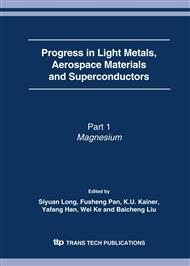[1]
International Magnesium Association (IMA) Report, 2002, in eds., (2002).
Google Scholar
[2]
D. A. Kramer: Magnesium Recycling in the United States in 1998, pubs. usgs. gov/of/2001/of01-166/of01-166. pdf, (1998).
Google Scholar
[3]
International Magnesium Association (IMA) Report, 1992, in eds., (1992).
Google Scholar
[4]
C. Scharf and A. Ditze: Present State of Recycling of Magnesium and its Alloys, Proceedings of the International Conference on Magnesium Alloys and Their Applications, B.L.M. a.K.U. Kainer, eds., (1998), 685-690.
DOI: 10.1002/3527602046.ch16
Google Scholar
[5]
http: /www. magnesium-elektron. com.
Google Scholar
[6]
www. amacro. us.
Google Scholar
[7]
www. magnesium. hydro. com.
Google Scholar
[8]
www. aleris. com.
Google Scholar
[9]
H. Antekowitsch, G. Hanko and P. Ebner: Magnesium technology 2002, TMS, (2002), 43-48.
Google Scholar
[10]
G. Hanko, H. Antrekowitsch and P. Ebner: JOM, (2002), 54(2), 51.
Google Scholar
[11]
M. R. Dahm: Magnesium technology 2000, TMS, (2000), 1333-1340.
Google Scholar
[12]
C. E. Meskers, A. Kvithyld, M. A. Reuter and T. A. Engh: Magnesium Technology 2006, The Minerals, Metals, and Materials Society, Warrendale, PA, (2006), Light Metal, 659-668.
Google Scholar
[13]
A. Kvithyld and T. A. Engh: private communication, (2003).
Google Scholar
[14]
H. Wentz and L. Ganim: Light Metal Age, (1992), 50(1-2), 14.
Google Scholar
[15]
K. Kimura, K. Nishii and M. Kawarada: FUJITSU Sci. Tech. J., (2002), 38(1), 102.
Google Scholar
[16]
S. G. Lee and A. M. Gokhale: Magnesium Technology 2006, N.R.N. A.A. Luo, and R.S. Beals, eds., The Minerals, Metals, and Materials Society, Warrendale, PA, (2006), Light Metals, 83-88.
Google Scholar
[17]
A. Javaid, E. Essadiqi, S. Bell and B. Davis:, Magnesium Technology 2006, N.R.N. A.A. Luo, and R.S. Beals, eds., The Minerals, Metals, and Materials Society, Warrendale, PA, (2006), Light Metals, 9-12.
Google Scholar
[18]
www. key-to-metals. com/Article82. htm: Molten Light Metal Processing: Part One.
Google Scholar
[19]
S. -h. NIE, S. -m. XIONG and X. -l. LIU: Magnesium Technology 2006, N.R.N. A.A. Luo, and R.S. Beals, eds., The Minerals, Metals, and Materials Society, Warrendale, PA, (2006), Light Metals, 19-23.
Google Scholar
[20]
A. Ditze: Magnesium technology 2000, TMS, (2000), 1341-1349.
Google Scholar
[21]
E. J. Øvrelid: private communication, (2006).
Google Scholar
[22]
C. Dagger: Magnesium Elektron Ltd, Report No., (2004).
Google Scholar
[23]
T. Zhu, N. Li, X. Mei, A. Yu and S. Shang: Magnesium technology 2001, TMS, (2001), 55-60.
Google Scholar


